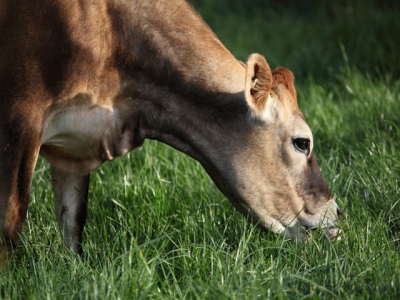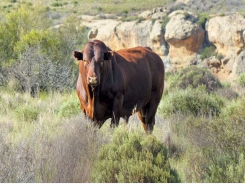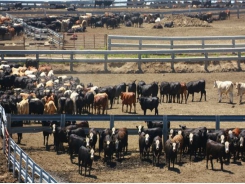Flaxseed oil use may boost milk yield for cold-stressed dairy cows

Flaxseed oil use in organic dairy cows diets improved performance, feed efficiency and milk yield in cold conditions and highly digestible dietary starch may boost omega-3 presence in milk, says researcher.
We caught up with Andre Brito, corresponding author and faculty scholar at the University of New Hampshire to hear more about his work published in the Journal of Dairy Science looking at feed ingredient interaction for dairy cows facing potential cold stress from year-round access to pasture.
The goal of the study was to examine the potential for use of an energy source, like flaxseed oil (FSO), in the ration of dairy cows that also included differently sized starch particles, he told us. “Those were the basic questions – primarily energy source [use] and understanding the processes behind the effects of corn particle size on milk fatty acids, primarily omega-3 fatty acids,” he added.
“Flaxseed oil or flax, in general, is very high in omega 3 fatty acids, also primarily α-linolenic acid (ALA),” he said. “There is not much information out there about how corn particle size – if you have cracked corn or ground corn, which supposedly have different starch degradability in the rumen – how that can impact the conversion of ALA acid in the diet, in the milk or the trans fats. Would particle size have an effect on the omega-3 that could be present in the milk?”
The research team hypothesized that FSO use would support higher yields for milk and milk components along with feed efficiency, and that ground corn would be more “extensively fermented” than the cracked corn and generate a larger proportion of trans fatty acid intermediates in the milk fat. They also anticipated that the FSO would interact with the particle size of the corn grain to alter production, nutrient use and milk and plasma fatty acid profile.
The use of the trial diets found that cows getting the oil supplement produced more milk, but did not have a greater intake, said Brito.
However, there also were some surprises in the data generated, he said. “I was hoping for many interactions to happen and it didn’t – we had some. ALA had some interaction, but I was expecting to see more maybe in production and milk production, but we didn’t see much of that.”
Why oil and particle size?
Flaxseed oil (FSO) is a source of ALA, the researchers said.
Cows in organic dairy production systems may be susceptible to cold stress during winter months as federal organic regulations say that animals have to have year-round access to the outdoors, they said. Cold stress could lower dry matter intake and milk yield.
Adding FSO to diets could be a way to boost energy intake and support milk yield loss, they said. However, there have been inconsistent results when feeds were supplemented with FSO.
In the previous studies, cows had diets that were hay or silage based, they said. No information is available regarding the use of FSO with cows given a grass-legume baleage.
The oil may interact with forage source in the diet to modulate ruminal fermentation, DMI and milk yield, the researchers said. Past research suggested that feeding flaxseed to dairy cows increased amounts of ALA and other fatty acids in milk, but the effect appears to vary based on cereal grain source
There also were some questions raised about the production of trans fatty acid intermediates, which have been linked to milk fat depression, when dietary starch degradability increased, they said. More information is needed to understand potential interactions among dietary oil, cereal grain particle size and the milk fatty acid profile.
Feeding study details
In the feeding trial, 12 multiparous cows and four primiparous cows were given one of four diets for a period of 24 days before rotating to another trial diet, the researchers said. The overall feeding trial lasted for 96 days.
The diets included a diet with no FSO and 27.1% ground corn (GC), a diet with no FSO and 28.3% cracked corn (CC), a diet with 3% FSO and 27.1% GC and a diet with 3% FSO and 28.3% CC, they said. Diets were fed as a total mixed ration (TMR) along with a baleage.
Samples of baleage, TMR and refusals were collected for analysis, they said. Milk weights were recorded and samples were collected.
Blood samples also were taken for analysis along with urine and manure, they said.
To address the cold-weather challenge aspect of feeding habits and milk production, the study was started in mid-February with cows that had continual access to the outdoors, said Brito. That element was of interest because dairy cows raised in an organic production system need to have access to pasture.
The oil was included in the diet as a way to potentially mitigate the cold challenge that cows face from winter conditions, he said. “It helps the cows to generate heat … the cows are partitioning energy toward heat production and less to milk production.”
Results
There were some surprises in the results, said Brito, as there was an expectation that the trans fatty acid intermediates would produce more milk fat depression when diets with smaller particle sizes were used.
“With a smaller particle size you expect more fermentation – and then maybe a reduction in pH and that leads to more trans [FA intermediates] we didn’t see those happen,” he said. The rest of the diet could have played a role, he added.
“Baleage is a long particle size that stimulates a lot of chewing and rumination and saliva,” he said. “I think that buffered some of the potential interactions. If we’d been feeding of a traditional TRM with smaller particle size we were probably going to see more of those interactions coming to play here.”
Overall, milk production along with milk fat, lactose and feed efficiency increased when cows had the FSO added to their diets, the researchers said.
However, the second hypothesis that different particle sizes would alter the amount of trans fatty acids intermediates and improve milk nitrogen efficient was not supported, they said. No FSO and corn particle size interaction was noted for production and nutrient digestibility.
There was an interaction between FSO and corn particle size for milk ALA, they said. The largest proportion of ALA was found in the milk of cows fed FSO and ground corn.
Additionally, there remain questions to be answered regarding the interactions between particle size and the use of oil in the diet, said Brito. The diet used in the study may be more typical of what is found in organic production systems or in the Northeast.
It includes larger amounts of baleage than other dairy cattle diets might, he said. Corn silage is a common ingredient for cows in other locations.
“There are still active questions [of] how this would effect if we see a more typical TMR,” he said. “You can see the original idea was more targeting the organic dairy sector where they feed the higher levels of baleage and no corn silage.”
Source: Journal of Dairy Science
Authors: V. Brossillon, S. Reis, D. Moura, J. Galvão Jr., A. Oliveira, C. Côrtes, and A. Brito
Related news
Tools

Phối trộn thức ăn chăn nuôi

Pha dung dịch thủy canh

Định mức cho tôm ăn

Phối trộn phân bón NPK

Xác định tỷ lệ tôm sống

Chuyển đổi đơn vị phân bón

Xác định công suất sục khí

Chuyển đổi đơn vị tôm

Tính diện tích nhà kính

Tính thể tích ao




 Fibrolytic enzymes could boost dairy cow efficiency
Fibrolytic enzymes could boost dairy cow efficiency  Cattle disease traceability project moving forward
Cattle disease traceability project moving forward